Gentamicin and Citronella-Derived Compounds as Dual Modulators of Inflammation-Associated Targets in Acne Vulgaris
Abstract
1. Introduction
2. Results and Discussion
2.1. Differential Gene Expression Analysis
2.2. Meta-Analysis
2.2.1. SPTBN1 (Spectrin Beta, Non-Erythrocytic 1)
2.2.2. SIPA1L1 (Signal-Induced Proliferation-Associated 1 Like 1)
2.3. Structural Elucidation of SPTBN1 and SIPA1L1
2.4. Molecular Docking Results
2.4.1. Binding Pocket Interactions of Gentamicin with SPTBN1
2.4.2. Molecular Dynamics Simulation of Gentamicin–SPTBN1 Complex
Energy Stability of the Gentamicin–SPTBN1 Complex
Interaction Energy Decomposition Analysis of the Gentamicin–SPTBN1 Complex
Residue Flexibility Analysis of the Gentamicin–SPTBN1 Complex
2.5. Binding Pocket Interactions of Gentamicin with SIPA1L1
2.5.1. Molecular Dynamics Simulation of the Gentamicin–SIPA1L1 Complex
Energy Stability Analysis of the Gentamicin–SIPA1L1 Complex
Interaction Energy Decomposition Analysis of the Gentamicin–SIPA1L1 Complex
Flexibility Analysis of the Gentamicin–SIPA1L1 Complex
3. Methodology
3.1. Data Source and Search Strategy
3.2. Target Protein Retrieval
3.3. Ligand Retrieval
3.4. Ligand Preparation
3.5. Protein Preparation
3.6. Molecular Docking
3.7. Molecular Dynamics Simulation
3.8. Post-MD Analysis
4. Conclusions
Author Contributions
Funding
Institutional Review Board Statement
Informed Consent Statement
Data Availability Statement
Conflicts of Interest
References
- Leyden, J.J.; Del Rosso, J.Q.; Webster, G.F. Clinical considerations in the treatment of Acne Vulgaris and other inflammatory skin disorders: A status report. Dermatol. Clin. 2009, 27, 1–15. [Google Scholar] [CrossRef]
- Nagy, I.; Pivarcsi, A.; Kis, K.; Koreck, A.; Bodai, L.; McDowell, A.; Seltmann, H.; Patrick, S.; Zouboulis, C.C.; Kemény, L. Propionibacterium acnes and lipopolysaccharide induce the expression of antimicrobial peptides and proinflammatory cytokines/chemokines in human sebocytes. Microbes Infect. 2006, 8, 2195–2205. [Google Scholar] [CrossRef]
- Bowe, W.P.; Shalita, A.R. Effective over-the-counter acne treatments. Semin. Cutan. Med. Surg. 2008, 27, 170–176. [Google Scholar] [CrossRef]
- Dangol, S.; Poudel, D.K.; Ojha, P.K.; Maharjan, S.; Poudel, A.; Satyal, R.; Rokaya, A.; Timsina, S.; Dosoky, N.S.; Satyal, P.; et al. Essential Oil Composition Analysis of Cymbopogon Species from Eastern Nepal by GC-MS and Chiral GC-MS, and Antimicrobial Activity of Some Major Compounds. Molecules 2023, 28, 543. [Google Scholar] [CrossRef] [PubMed]
- Dessinioti, C.; Katsambas, A. Propionibacterium acnes and antimicrobial resistance in acne. Clin. Dermatol. 2017, 35, 163–167. [Google Scholar] [CrossRef]
- Yang, P.; Yang, Y.; Sun, P.; Tian, Y.; Gao, F.; Wang, C.; Zong, T.; Li, M.; Zhang, Y.; Yu, T.; et al. βII spectrin (SPTBN1): Biological function and clinical potential in cancer and other diseases. Int. J. Biol. Sci. 2021, 17, 32–49. [Google Scholar] [CrossRef]
- Lin, L.; Chen, S.; Wang, H.; Gao, B.; Kallakury, B.; Bhuvaneshwar, K.; Cahn, K.; Gusev, Y.; Wang, X.; Wu, Y.; et al. SPTBN1 inhibits inflammatory responses via stabilization of SOCS1 and downregulation of NF-κB p65 in hepatocellular carcinoma. Theranostics 2021, 11, 4232–4250. [Google Scholar] [CrossRef] [PubMed]
- Dréno, B.; Dagnelie, M.A.; Khammari, A.; Corvec, S. The skin microbiome: A new actor in inflammatory acne. Am. J. Clin. Dermatol. 2020, 21, 18–24. [Google Scholar] [CrossRef] [PubMed]
- Matsuura, K.; Kobayashi, S.; Konno, K.; Yamasaki, M.; Horiuchi, T.; Senda, T.; Hayashi, T.; Satoh, K.; Arima-Yoshida, F.; Iwasaki, K.; et al. SIPA1L1/SPAR1 interacts with neurabin family proteins and regulates Rap signaling at synaptic junctions. J. Neurosci. 2022, 42, 4785–4801. [Google Scholar] [CrossRef]
- Melnik, B.C. Acne Vulgaris: Pathogenesis and treatment. Clin. Cosmet. Investig. Dermatol. 2015, 8, 371–388. [Google Scholar] [CrossRef]
- Bergler-Czop, B.; Brzezińska-Wcisło, L. Effect of isotretinoin on serum cytokine levels in patients with Acne Vulgaris. Postepy Dermatol. Alergol. 2014, 31, 21–28. [Google Scholar] [CrossRef] [PubMed]
- Zhi, X.; Lin, L.; Yang, S.; Bhuvaneshwar, K.; Wang, H.; Gusev, Y.; Lee, M.H.; Kallakury, B.; Shivapurkar, N.; Cahn, K.; et al. βII-Spectrin (SPTBN1) suppresses progression of hepatocellular carcinoma and Wnt signaling by regulation of Wnt inhibitor kallistatin. Hepatology 2015, 61, 598–612. [Google Scholar] [CrossRef] [PubMed]
- Śledź, P.; Caflisch, A. Protein structure-based drug design: From docking to molecular dynamics. Curr. Opin. Struct. Biol. 2018, 48, 93–102. [Google Scholar] [CrossRef] [PubMed]
- Lazniewski, M.; Dermawan, D.; Hidayat, S.; Muchtaridi, M.; Dawson, W.K.; Plewczynski, D. Drug repurposing for identification of potential spike inhibitors for SARS-CoV-2 using molecular docking and molecular dynamics simulations. Methods 2022, 203, 498–510. [Google Scholar] [CrossRef]
- Li, J.; Xu, F.; Li, S.; Xie, M.; Li, N. Gentamicin promoted the production of CD4+CD25+ Tregs via the STAT5 signaling pathway in mice sepsis. BMC Immunol. 2022, 23, 47. [Google Scholar] [CrossRef]
- Tisserand, R.; Young, R. Essential Oil Safety: A Guide for Health Care Professionals; Elsevier Health Sciences: Amsterdam, The Netherlands, 2013. [Google Scholar]
- Yadav, D.K.; Rathee, S.; Sharma, V.; Patil, U.K. A Comprehensive Review on Insect Repellent Agents: Medicinal Plants and Synthetic Compounds. Anti-Inflamm. Anti-Allergy Agents Med. Chem. 2024, 24, 84–102. [Google Scholar] [CrossRef]
- Devi, M.; Bamrah, P.K.; Goyal, R.; Choudhary, M.; Chopra, H. Insights on the emerging therapeutic potential of terpenoids as anti-inflammatory agents: A scoping review. J. Bio-X Res. 2024, 7, 0006. [Google Scholar] [CrossRef]
- Hu, B.; Wang, H.; Liang, H.; Ma, N.; Wu, D.; Zhao, R.; Lv, H.; Xiao, Z. Multiple effects of spicy flavors on neurological diseases through the intervention of TRPV1: A critical review. Crit. Rev. Food Sci. Nutr. 2024, 65, 3987–4006. [Google Scholar] [CrossRef]
- Gao, W.; Guo, L.; Yang, Y.; Wang, Y.; Xia, S.; Gong, H.; Zhang, B.-K.; Yan, M. Dissecting the crosstalk between Nrf2 and NF-κB response pathways in drug-induced toxicity. Front. Cell Dev. Biol. 2022, 9, 809952. [Google Scholar] [CrossRef]
- Elmaidomy, A.H.; Shady, N.H.; Abdeljawad, K.M.; Elzamkan, M.B.; Helmy, H.H.; Tarshan, E.A.; Adly, A.N.; Hussien, Y.H.; Sayed, N.G.; Zayed, A.; et al. Antimicrobial potentials of natural products against multidrug resistance pathogens: A comprehensive review. RSC Adv. 2022, 12, 29078–29102. [Google Scholar] [CrossRef]
- Dallakyan, S.; Olson, A.J. Small-molecule library screening by docking with PyRx. In Chemical Biology: Methods and Protocols; Springer: New York, NY, USA, 2014; pp. 243–250. [Google Scholar]
- Pawar, R.P.; Rohane, S.H. Role of autodock vina in PyRx molecular docking. Asian J. Res. Chem. 2021, 14, 132–134. [Google Scholar]
- Van Der Spoel, D.; Lindahl, E.; Hess, B.; Groenhof, G.; Mark, A.E.; Berendsen, H.J.C. GROMACS: Fast, flexible, and free. J. Comput. Chem. 2005, 26, 1701–1718. [Google Scholar] [CrossRef] [PubMed]

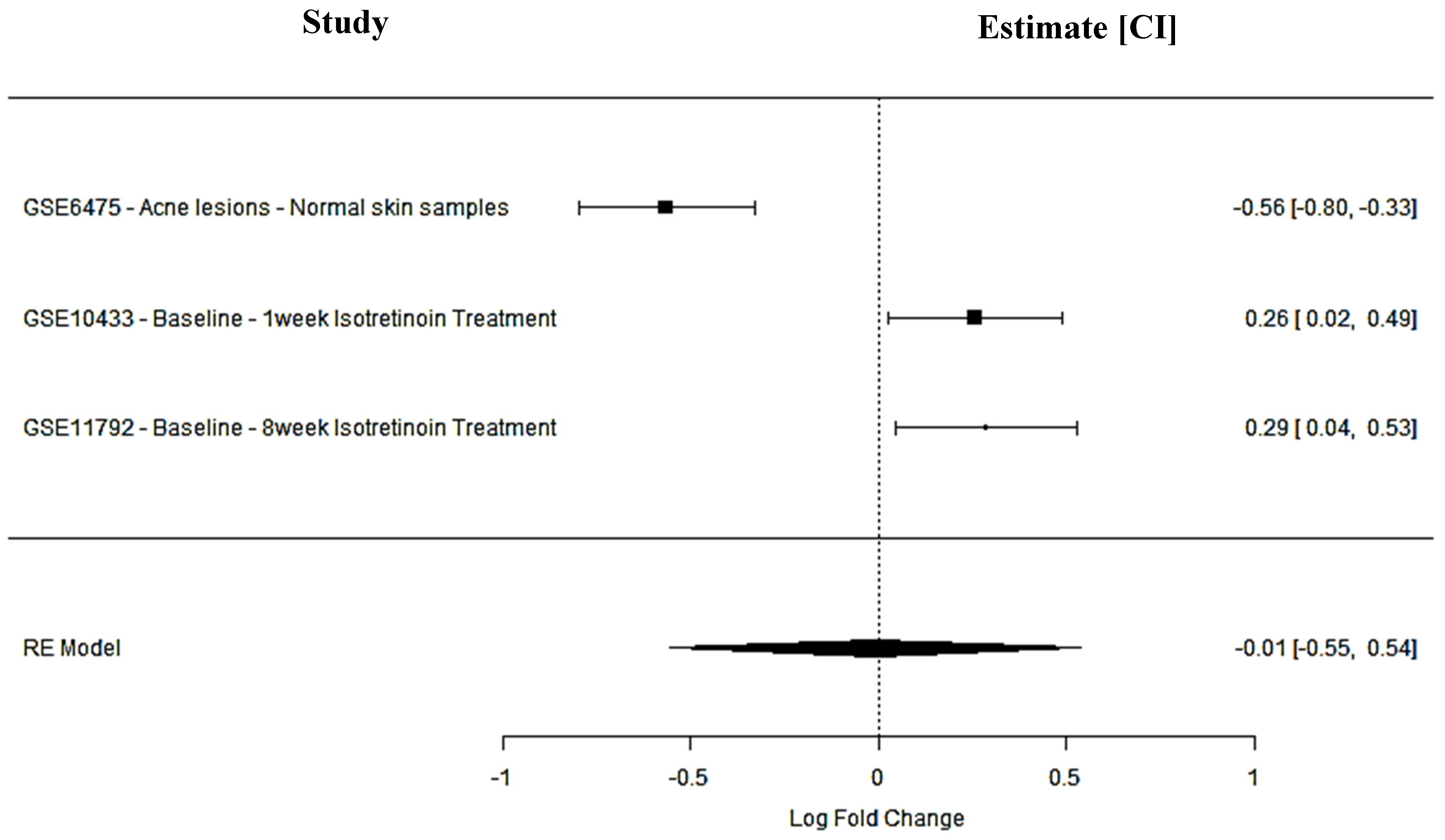
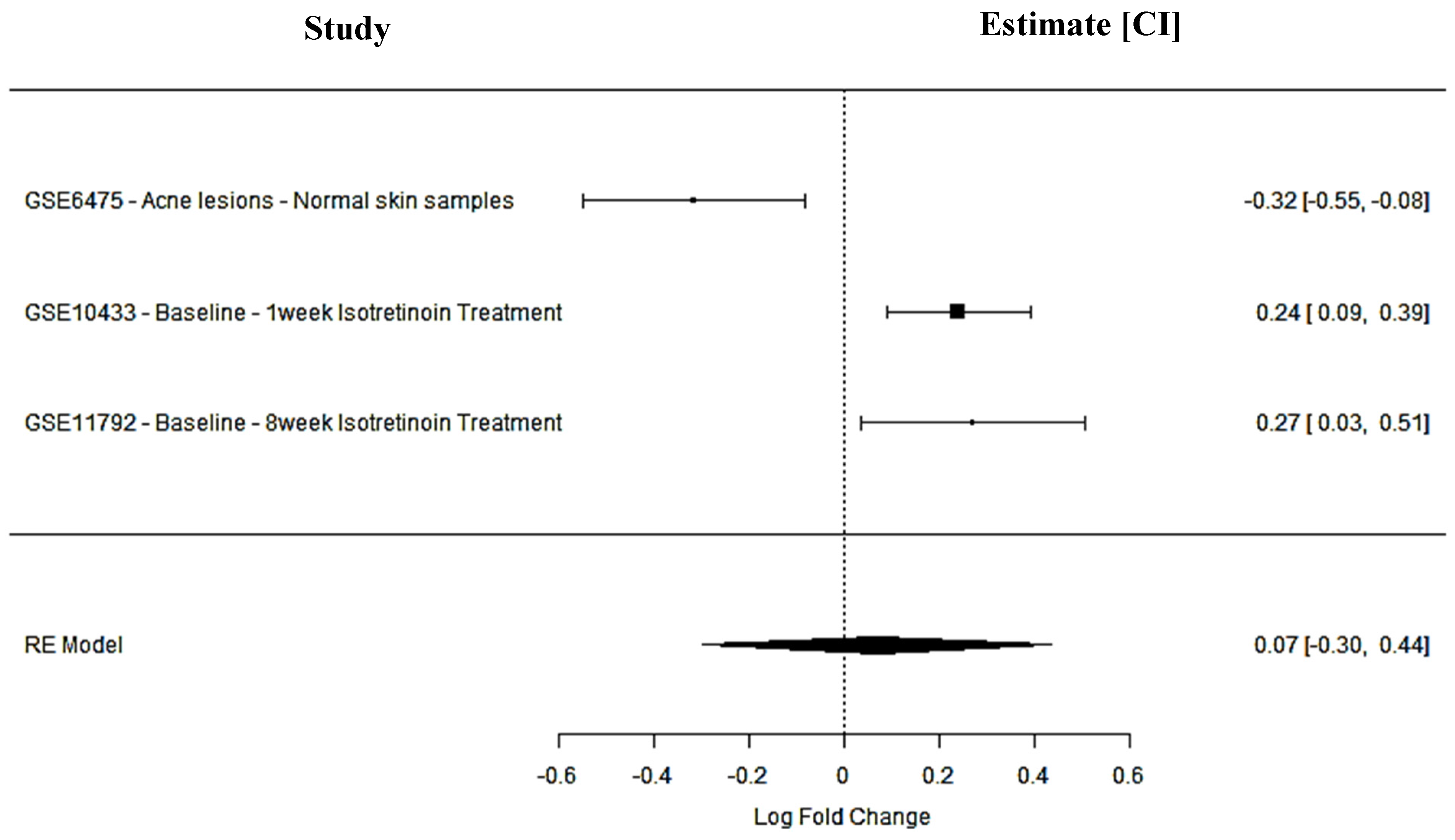


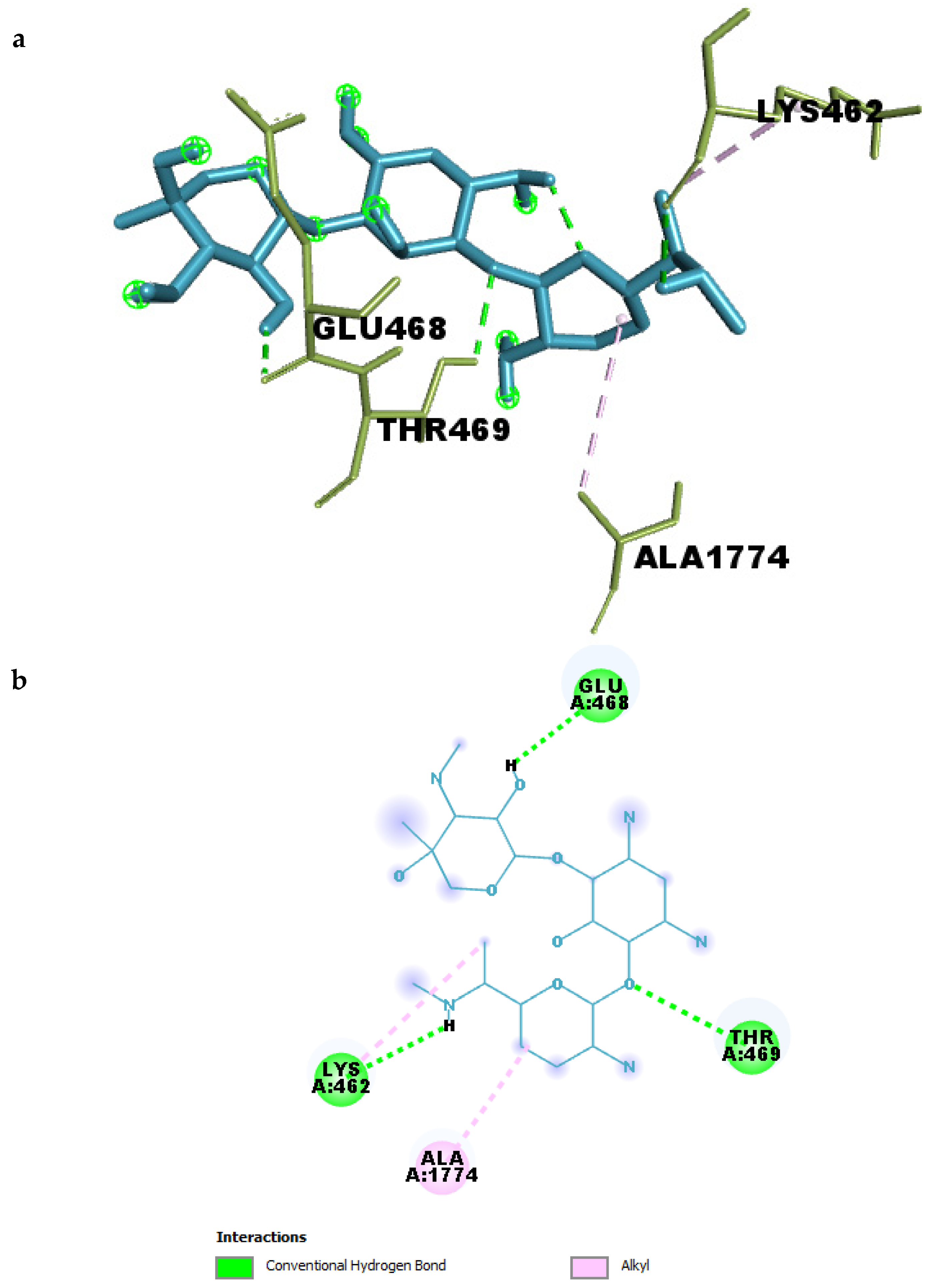
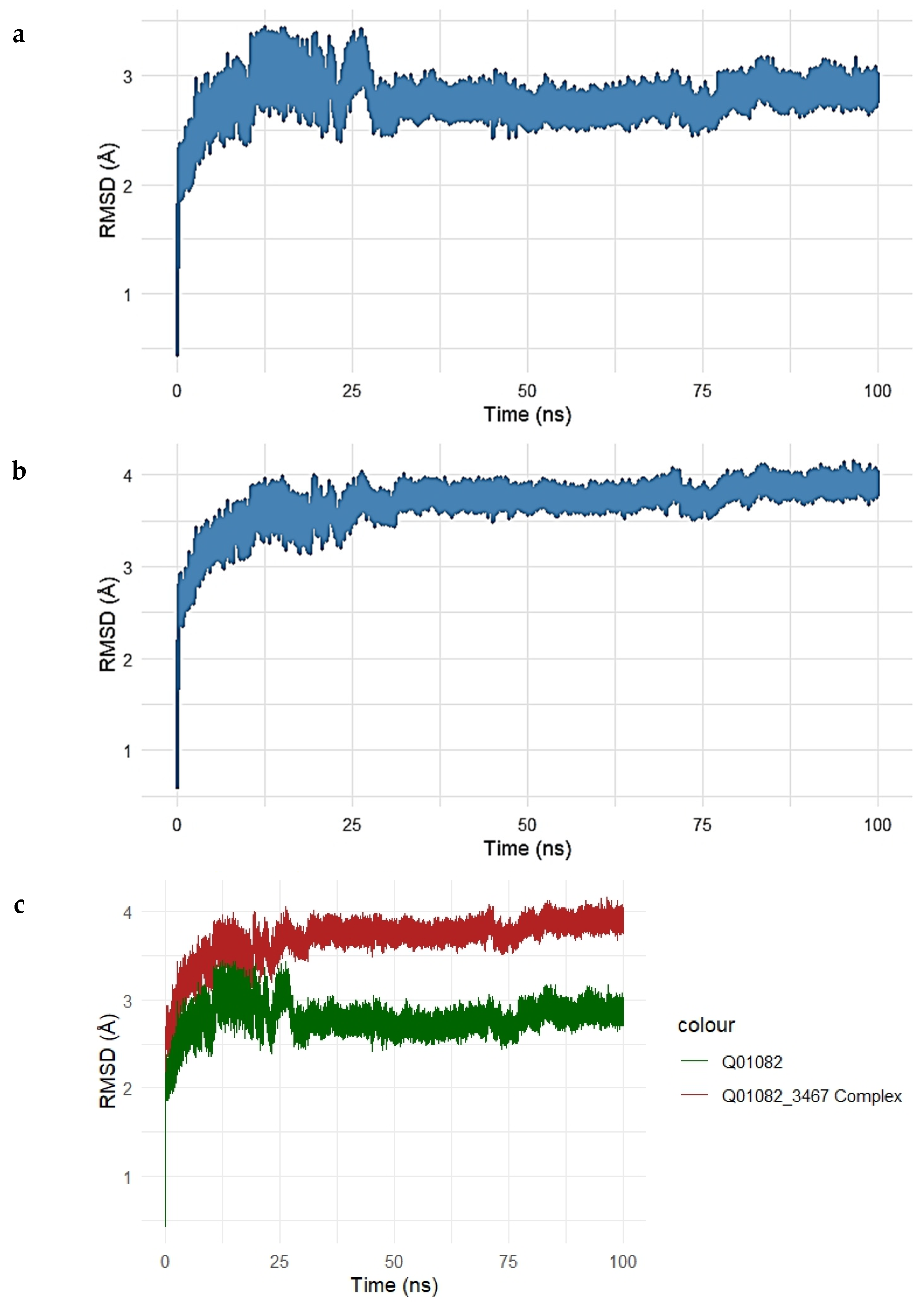

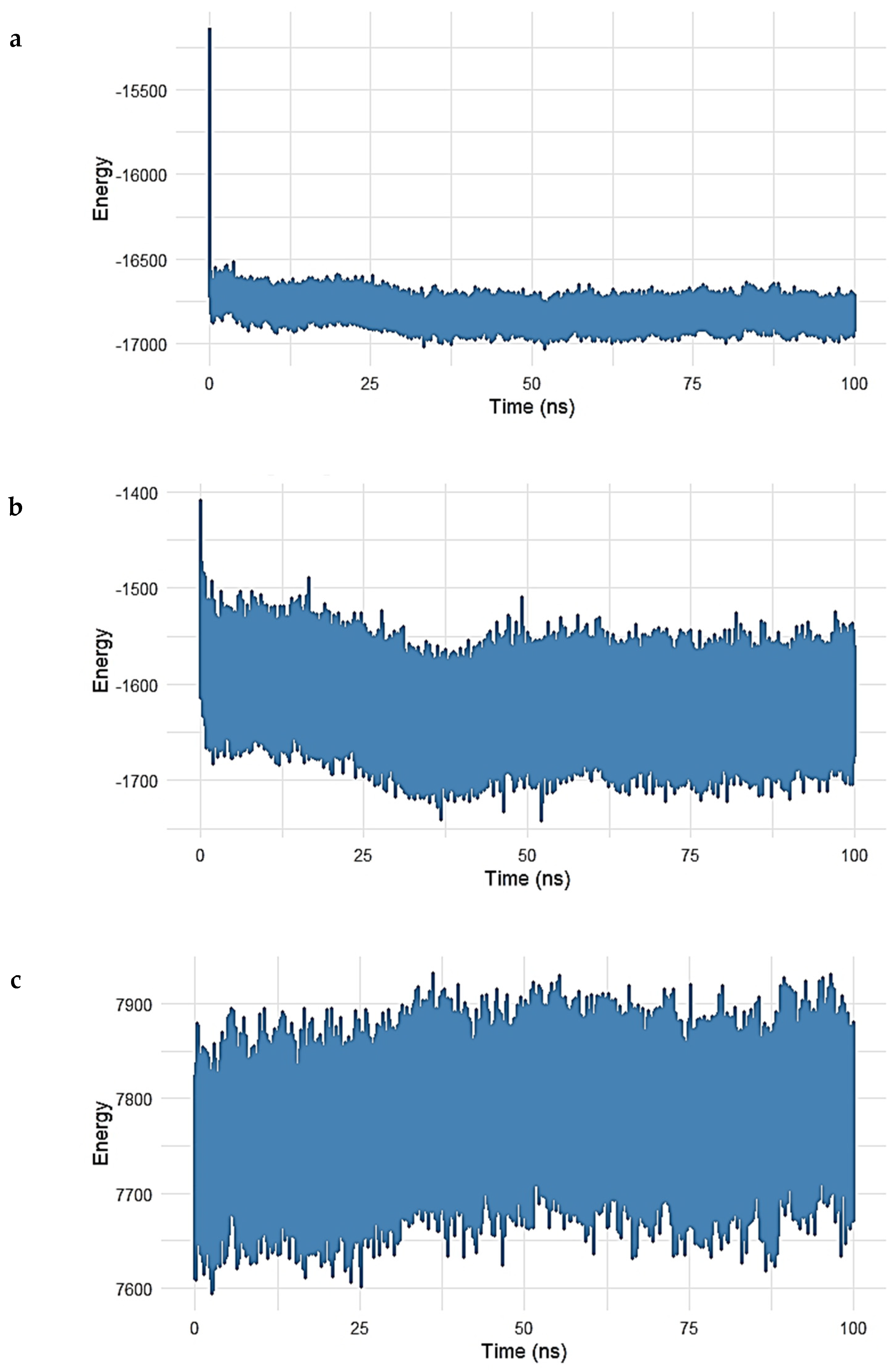
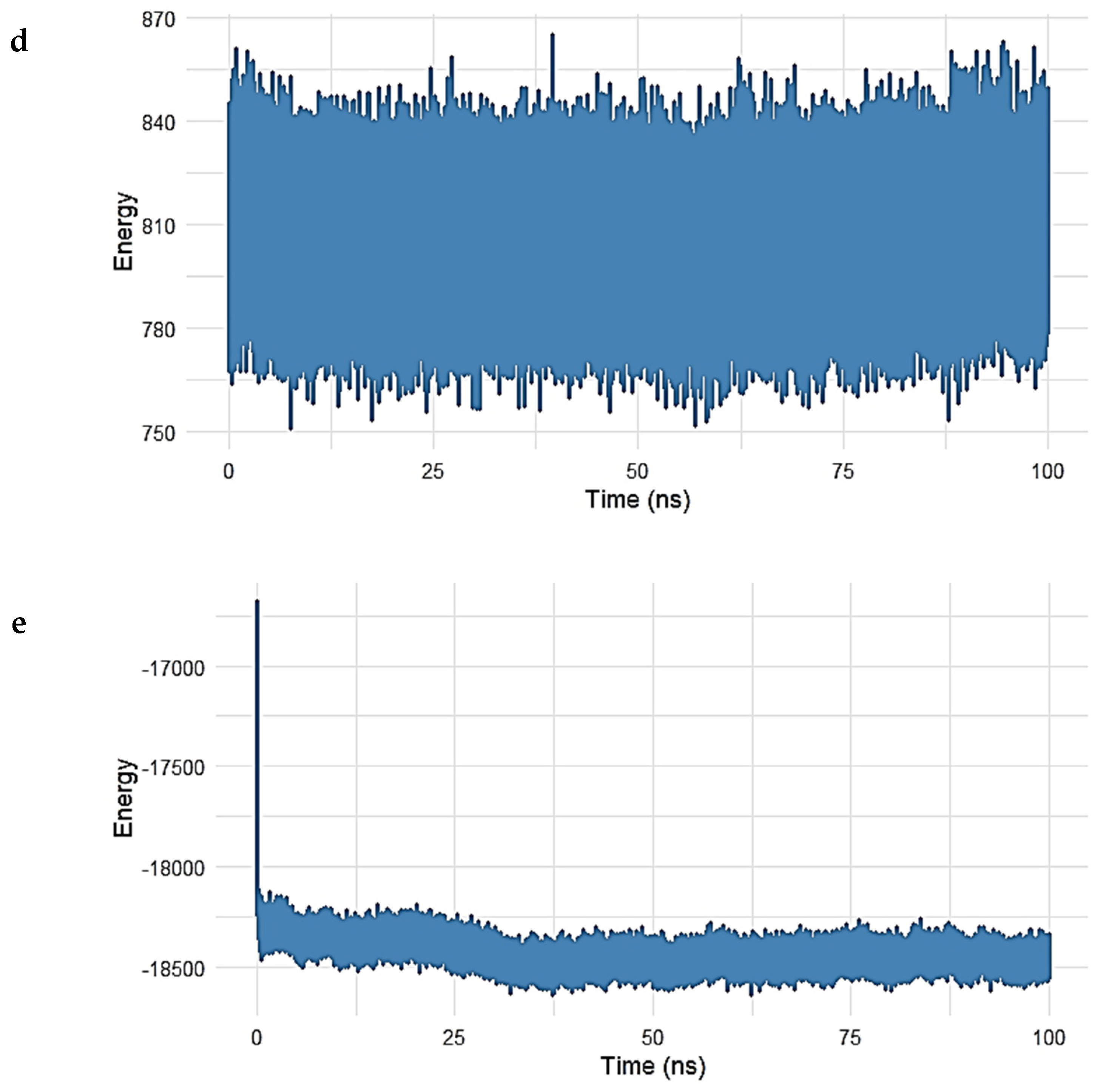


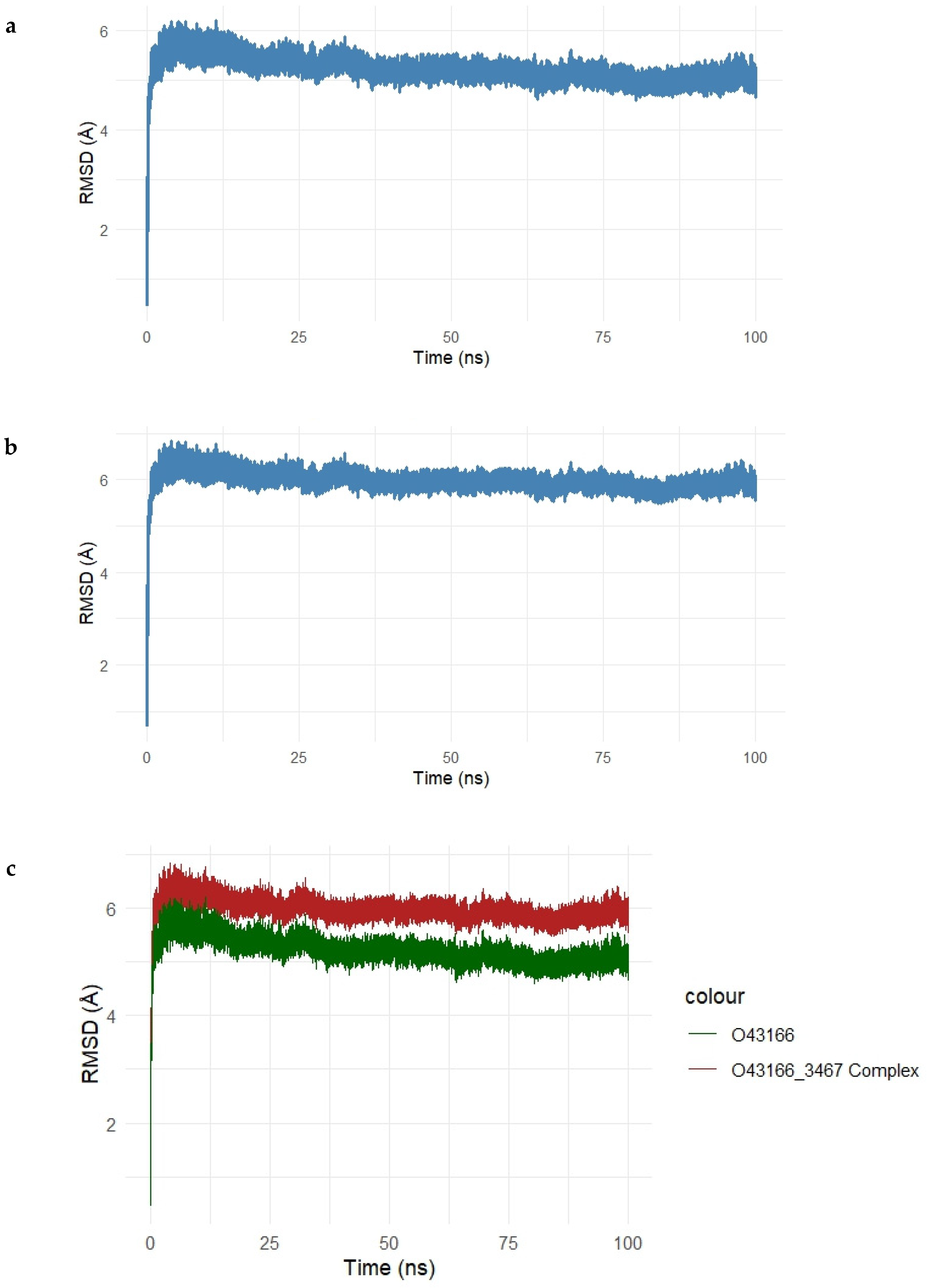
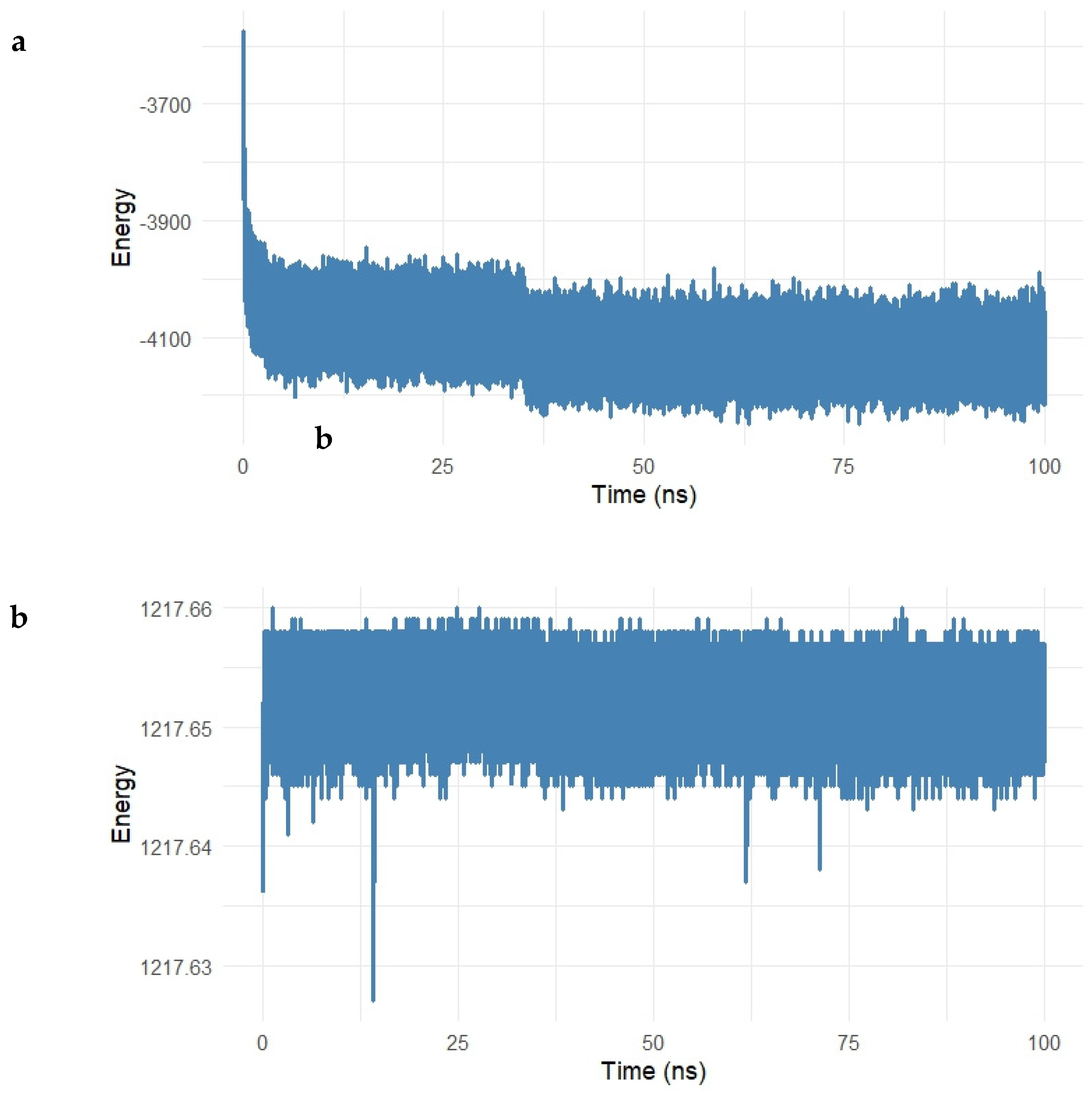

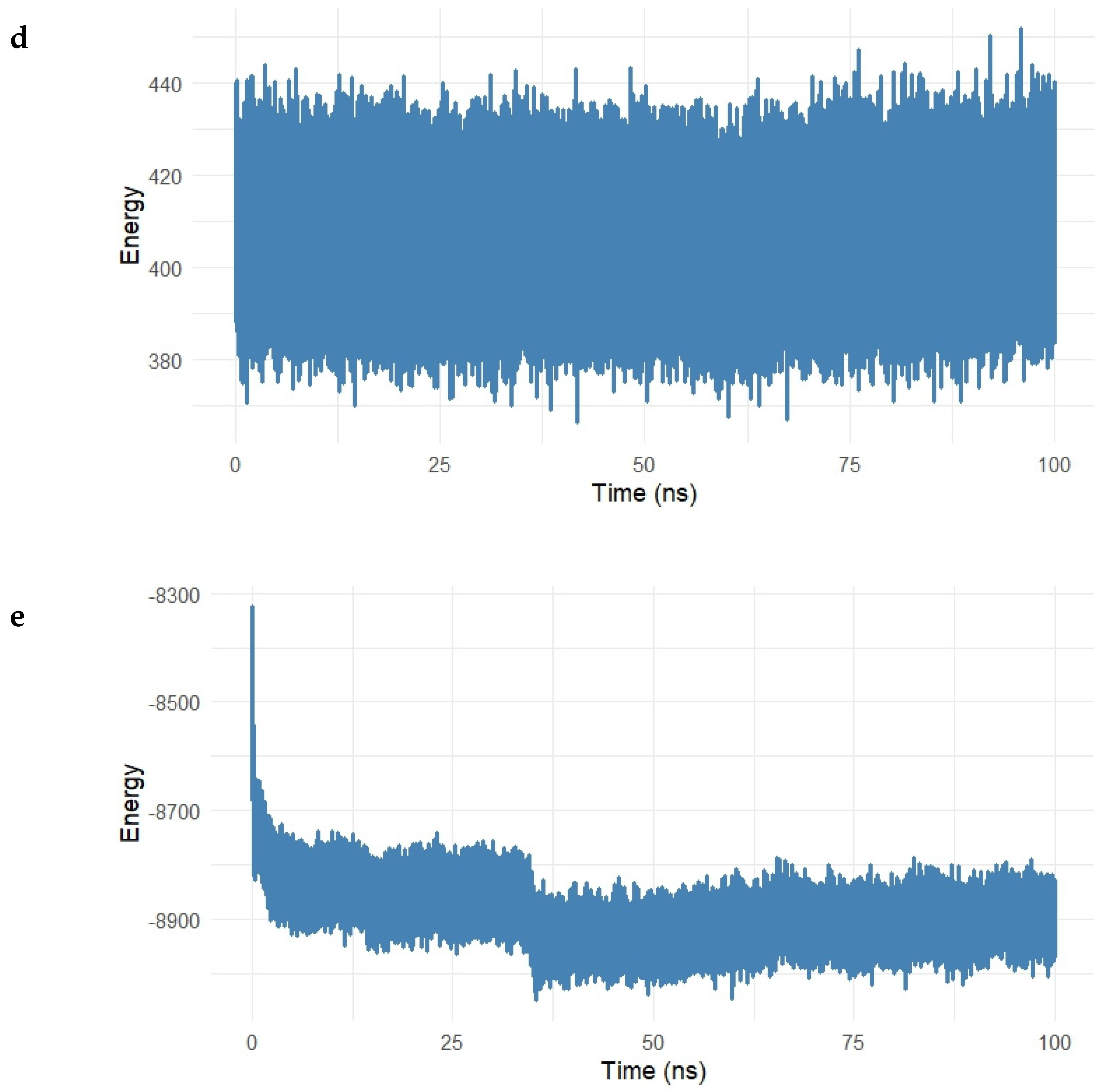
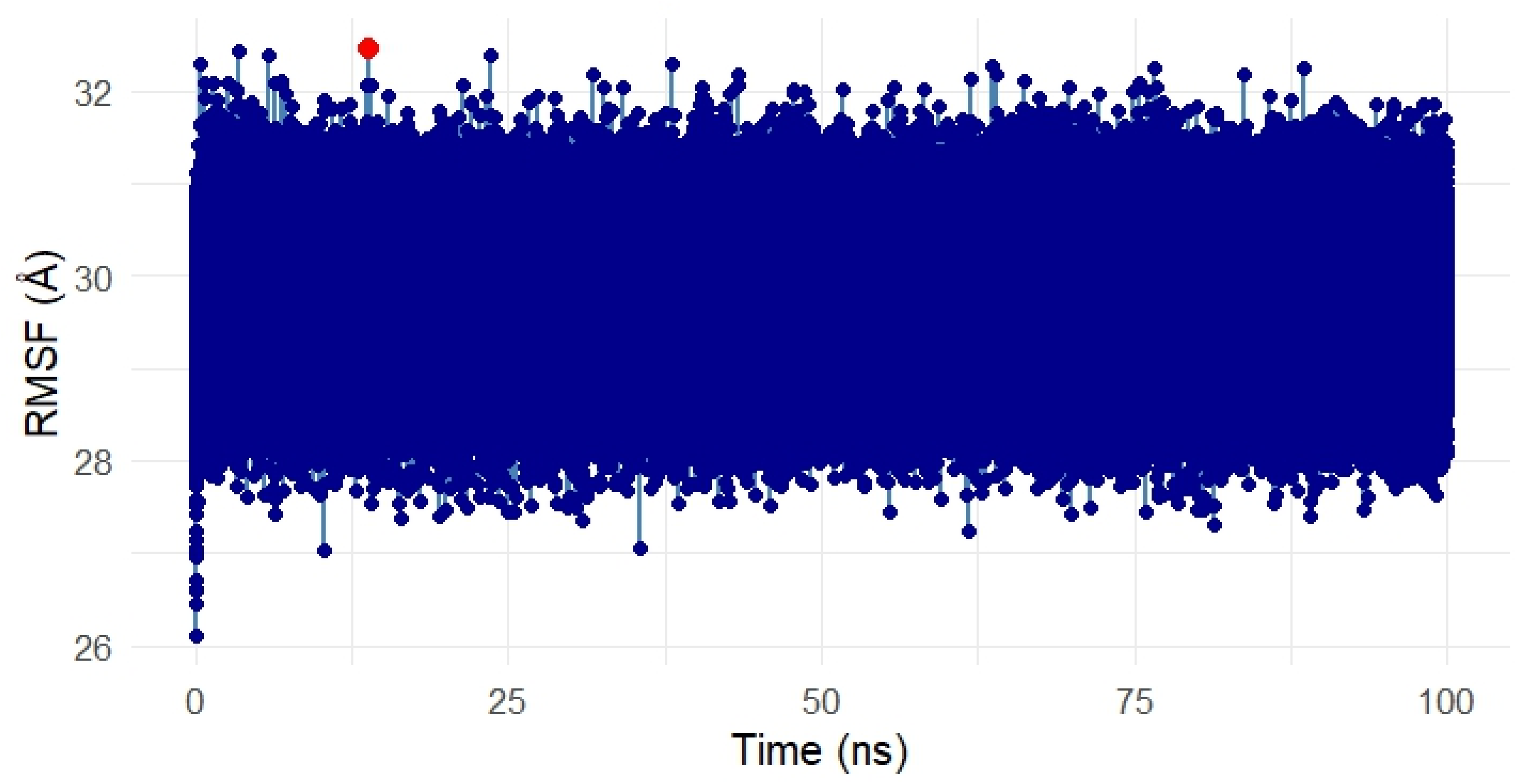
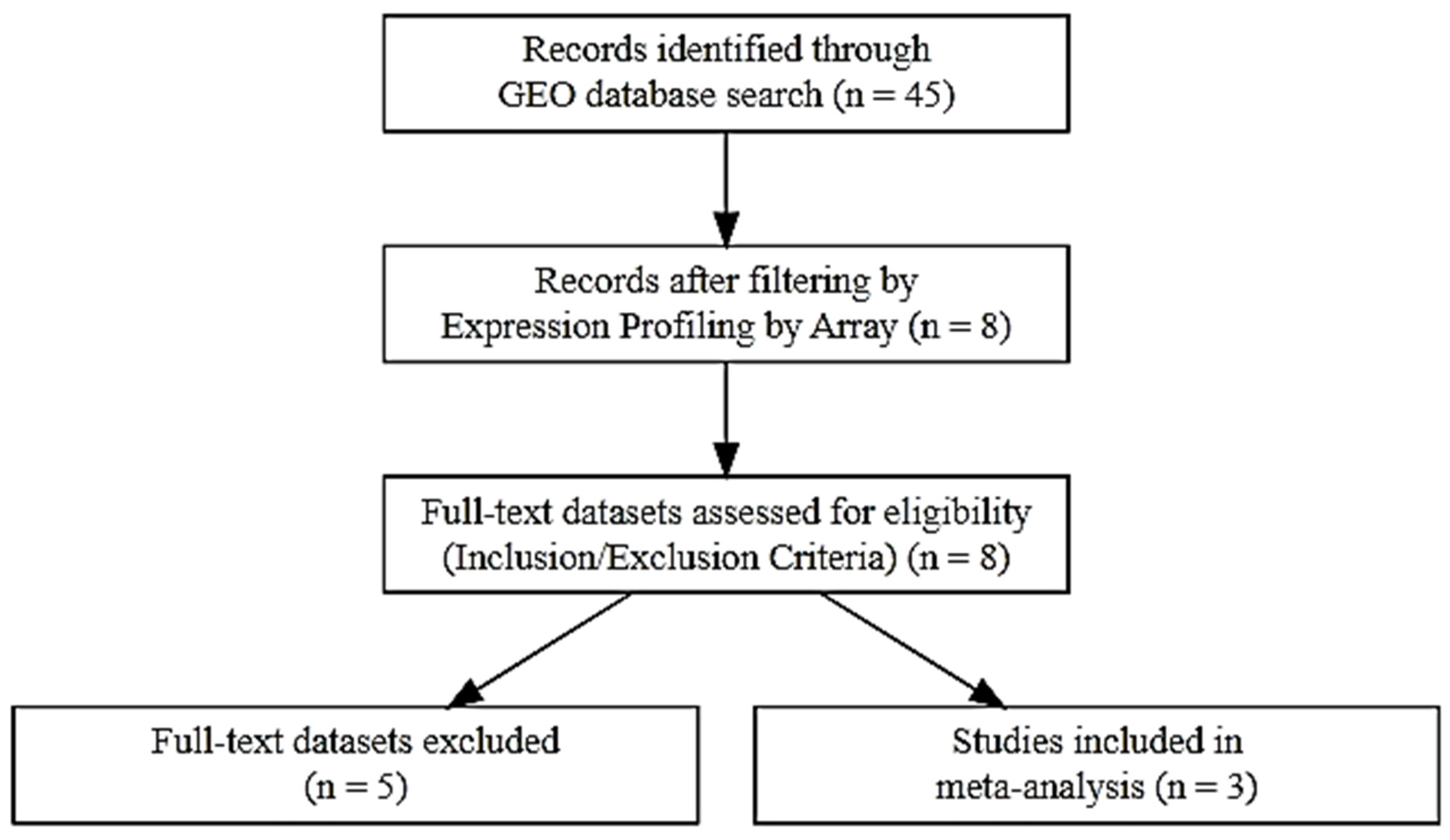
| Gene | logFC | SE | p-Value | CI_LB | CI_UB | I2 | tau2 |
|---|---|---|---|---|---|---|---|
| SPTBN1 | −0.00768 | 0.278541 | 0.978007 | −0.55361 | 0.538252 | 93.82046 | 0.218364 |
| SIPA1L1 | 0.068953 | 0.187613 | 0.713225 | −0.29876 | 0.436667 | 89.6881 | 0.094233 |
| Compounds | PubChem ID | Binding Affinity (kcal/mol) | |
|---|---|---|---|
| O43166 (SIPA1L1) | Q01082 (SPTBN1) | ||
| Gentamicin | 3467 | −8.6 | −5.9 |
| Citronellal | 7794 | −5.1 | −3.9 |
| Citronellol | 8842 | −4.9 | −3.9 |
| Geraniol | 637566 | −5.1 | −4 |
| Citral | 638011 | −5.3 | −4.4 |
| Name | XYZ: X | XYZ: Y | XYZ: Z | Distance | Category | Types |
|---|---|---|---|---|---|---|
| A:THR469:HG1—N:UNK1:O | −5.35 | −5.285 | −5.94 | 2.48642 | Hydrogen Bond | Conventional Hydrogen Bond |
| N:UNK1:H—A:GLU468:O | −5.595 | −5.118 | −11.749 | 2.18653 | Hydrogen Bond | Conventional Hydrogen Bond |
| N:UNK1:H—A:LYS462:O | −5.462 | −10.4225 | −3.84 | 2.5903 | Hydrogen Bond | Conventional Hydrogen Bond |
| N:UNK1:H—N:UNK1:O | −7.251 | −6.2815 | −3.388 | 2.26536 | Hydrogen Bond | Conventional Hydrogen Bond |
| A:ALA1774—N:UNK1 | −2.33283 | −5.24483 | −3.308 | 4.68248 | Hydrophobic | Alkyl |
| N:UNK1:C—A:LYS462 | −7.39817 | −10.1332 | −1.0585 | 3.93045 | Hydrophobic | Alkyl |
| Name | XYZ: X | XYZ: Y | XYZ: Z | Distance | Category | Types |
|---|---|---|---|---|---|---|
| A:HIS484:HD1—N:UNK1:O | −6.0465 | 6.165 | −2.399 | 2.92598 | Hydrogen Bond | Conventional Hydrogen Bond |
| A:VAL895:HN—N:UNK1:O | −9.0935 | 6.457 | 0.3795 | 2.29179 | Hydrogen Bond | Conventional Hydrogen Bond |
| N:UNK1:H—A:ASN457:O | −6.663 | 4.8475 | 2.488 | 2.04784 | Hydrogen Bond | Conventional Hydrogen Bond |
| N:UNK1:H—A:VAL460:O | −6.666 | 2.162 | 1.832 | 2.28452 | Hydrogen Bond | Conventional Hydrogen Bond |
| N:UNK1:H—A:THR892:O | −12.508 | 8.568 | −4.787 | 2.14731 | Hydrogen Bond | Conventional Hydrogen Bond |
| A:LYS797—N:UNK1 | −8.48533 | 4.51433 | −7.24017 | 3.77049 | Hydrophobic | Alkyl |
| N:UNK1:C—A:PRO762 | −6.743 | 10.0728 | −5.02483 | 5.30008 | Hydrophobic | Alkyl |
| N:UNK1:C—A:PRO762 | −7.408 | 8.46733 | −7.10683 | 4.03608 | Hydrophobic | Alkyl |
| N:UNK1:C—A:LYS797 | −7.92183 | 6.03483 | −7.33317 | 3.92415 | Hydrophobic | Alkyl |
| GEO Accession | Study Description | Sample Groups | Total Samples |
|---|---|---|---|
| GSE6475 | Expression profiling of acne lesions and normal skin samples to identify baseline gene expression differences in Acne Vulgaris. |
| 18 |
| GSE10433 | Gene expression analysis before and after 1-week isotretinoin treatment to identify early response genes. |
| 12 |
| GSE11792 | Gene expression profiling of skin samples before and after 8-week isotretinoin treatment to assess long-term transcriptional changes. |
| 16 |
Disclaimer/Publisher’s Note: The statements, opinions and data contained in all publications are solely those of the individual author(s) and contributor(s) and not of MDPI and/or the editor(s). MDPI and/or the editor(s) disclaim responsibility for any injury to people or property resulting from any ideas, methods, instructions or products referred to in the content. |
© 2025 by the authors. Licensee MDPI, Basel, Switzerland. This article is an open access article distributed under the terms and conditions of the Creative Commons Attribution (CC BY) license (https://creativecommons.org/licenses/by/4.0/).
Share and Cite
Kola-Mustapha, A.T.; Raji, M.A.; Zarroug, S.H.O.; Ambrose, G.O. Gentamicin and Citronella-Derived Compounds as Dual Modulators of Inflammation-Associated Targets in Acne Vulgaris. Int. J. Mol. Sci. 2025, 26, 10628. https://doi.org/10.3390/ijms262110628
Kola-Mustapha AT, Raji MA, Zarroug SHO, Ambrose GO. Gentamicin and Citronella-Derived Compounds as Dual Modulators of Inflammation-Associated Targets in Acne Vulgaris. International Journal of Molecular Sciences. 2025; 26(21):10628. https://doi.org/10.3390/ijms262110628
Chicago/Turabian StyleKola-Mustapha, Adeola Tawakalitu, Muhabat Adeola Raji, Samah H. O. Zarroug, and George Oche Ambrose. 2025. "Gentamicin and Citronella-Derived Compounds as Dual Modulators of Inflammation-Associated Targets in Acne Vulgaris" International Journal of Molecular Sciences 26, no. 21: 10628. https://doi.org/10.3390/ijms262110628
APA StyleKola-Mustapha, A. T., Raji, M. A., Zarroug, S. H. O., & Ambrose, G. O. (2025). Gentamicin and Citronella-Derived Compounds as Dual Modulators of Inflammation-Associated Targets in Acne Vulgaris. International Journal of Molecular Sciences, 26(21), 10628. https://doi.org/10.3390/ijms262110628






